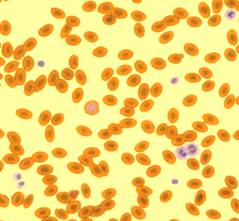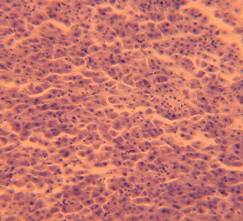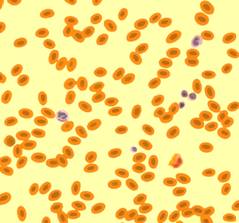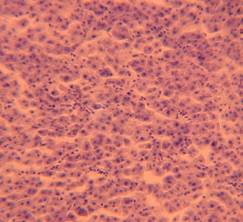УДК 639.3.05:575:57.08
INFLUENCE OF LIPOSOMAL NANOFORM OF FLAVOLIGNAN COMPLEX FROM Silybum marianum L. (SILYMARIN) ON MAIN ZOOTECHNICAL AND PHYSIOLOGICAL PARAMETERS IN BROILER-CHICKEN
V.I. Fisinin1, I.A. Egorov1, E.N. Andrianova1, E.A. Morina2, N.B. Fel’dman3, E.V. Lutsenko2, S.V. Lutsenko3
In broiler-chicken of Cobb Avian 48 cross having the liposomal nanoform of silymarine as food additive to their standard ration (GUP «Zagorskoe EPH VNITIP RASHN», Moskovskaya oblast’) the morphological and biochemical blood tests, pathomorphological study of liver, bacteriological study of feces and analysis of chemical content of poultry meat and growth indices were done. It was found out that adding of liposomal nanoform of silymarine facilitates zootechnical parameters of poultry: increases survival up to 100 %, less costly feed by 2.7 % with increasing of average weight gain by 1.3 %. In addition the authors marked that albumin-globulin index increased, total cholesterol decreased (by 23.8 %), calcium and phosphoric metabolism normalized, the activity of alanine aminotransferase and aspartate aminotransferase decreased. In the liver the increase of vitamin A content was noted. Thus, the authors made conclusion that liposomal nanoform of silymarin has positive effect on the state and the development of broiler-chicken.
Keywords: silymarine, liposome, poultry, broilers, average weight gain.
Recently, the global strategy of poultry farming is focused on quality, safety and environmental purity of products. Antibiotics and growth promoters are not used in most countries of EU (1, 2), but refusing chemotherapeutic medications can provoke development and subsequent spread of infectious diseases. This problem can be solved by creating the bird crosses resistant or low receptive to certain infections, which is though time-consuming and expensive. These facts make necessary finding effective and safe means - natural biologically active compounds. Natural extractives of plant origin provide a mild stimulating effect on metabolic processes in poultry, which has a positive effect on its productivity, intensifies the immune response and thereby increases viability and preservation of livestock. Another important advantage of plant extractives is their relatively low cost.
Previously, the authors reported about the new developed antimicrobial nanocomplex of Macleaya alkaloids and phospholipids exerting positive effects on main zootechnical, histological, hematological and biochemical indicators and not leading to dysbiosis in broiler chickens fed this supplement (3).
Silymarin – a flavonolignan complex extracted from milk thistle – is one of most promising plant bioactive substances. High antioxidant activity of silymarin (4-6) promotes immunity and health in poultry. Silymarin is also important for maintaining quality and safety of feeds by preventing them from rancidity and microbial contamination. Along with it, the pronounced hepatoprotective properties of silymarin make it a promising feed supplement when growing broiler chickens and laying hens as they need extra protection of the liver owing to high intensity of metabolic processes.
Therefore, silymarin can be widely used in agriculture, particularly in poultry farming. However, natural silymarin has a very low bioavailability, which limits the expression of its biological activity. A significant increase in bioavailability was achieved by creation of its liposomal nanoform (Science and Technical Center "Farmbiopress", Moscow). Numerous experiments (7, 8) have shown that the liposomal nanoform of silymarin has a much more pronounced therapeutic activity and allows introducing it in lower doses relative the native AI. In addition, essential phospholipids – components of the liposomal nanoform – can increase productivity and improve antioxidant status of poultry.
The purpose of this work was studying the safety of liposomal nanoform of silymarin and its impact on key parameters of poultry when introducing it to feed.
Technique. The research was performed in 2009 on broiler chickens the cross Cobb Avian 48 (control and experimental groups of 35 birds) bred in the vivarium of SUE "Zagorskoe the Experimental Production Enterprise of the All-Russia Research and Development Institute of Poultry Farming (VNITIP) of the RAAS” (Moscow province). The poultry was grown without separation by gender under the established technical conditions and fed ad libitum with dry full-value feed corresponding to nutritional standards recommended for the specified cross (9). The experimental group was fed the feed containing the investigated liposomal nanoform of silymarin at a dose of 200 g/t, without any feed antibiotics added (10). Veterinary activities were carried out according to the common program of the farm. During the experimental period, live weight of birds was measured in both groups by individual weighting to calculate its average daily gain and feed cost per 1 kg increase in body weight.
Morphological and biochemical blood tests were carried out by standard methods (11). Blood samples were collected on the 25th day of the experiment, the smears stained with azure and eosin were studied by microscopy. The complete blood count (CBC) included determination of blood color index, hemoglobin and erythrocyte sedimentation rate (ESR). The biochemical blood count was done to measure total protein content and contents of its fractions, enzyme activity of alanine aminotransferase (ALT) and aspartate aminotransferase (AST), cholesterol, concentrations of calcium and phosphorus.
In slaughtered chickens of both groups, there were analyzed chemical composition of meat and vitamin content of liver tissue. Histomorphological studies were performed on liver slices stained with hematoxylin and eosin (12).
The samples of liver and blood were studied with the microscope Mikromed-1 ("LOMO", Russia) at magnifications of ½100 and ½400.
Bacteriological test of feces was performed by inoculation on diagnostic nutrient media.
Statistical processing of results was performed using Microcal Origin software.
Results. Zootechnical observations have shown (Table 1) the absence of mortality in poultry fed the liposomal nanoform of silymarin, so the livestock preservation in this group exceeded that in control by 2,86% and equaled 100%. Another effect of silymarin liposome nanoform was manifested as decreased feed consumption and its enhanced conversion while the increased daily gain in body weight (Table 1). The observed changes can be the result of more active metabolism of nutrients in the body stimulated by silymarin.
1. General zootechnical parameters of broiler chickens the cross Cobb Avian 48 fed the liposomal nanoform of silymarin as feed supplement (experimental group) (vivarium of SUE “Zagorskoe the Experimental Production Enterprise of the All-Russia Research and Development Institute of Poultry Farming (VNITIP) of the RAAS”, Moscow province, 2009) |
||
Parameter |
Control group, n = 35 |
Experimental group, n = 35 |
Live weight, g (Х±х): |
|
|
1-day-old |
40 |
40 |
7-day-old |
162,71±2,48 |
165,37±2,75 |
21-day-old |
698,97±19,20 |
702,57±19,16 |
35-day-old |
1808,13±53,68 |
1831,60±49,64 |
Livestock preservation, % |
97,14 |
100 |
Cost of feed per 1 bird, kg |
3,12 |
3,02 |
Cost of feed per 1 kg increase in live weight, kg |
1,87 |
1,82 |
Average daily weight gain, g |
50,52 |
51,18 |
2. Morphological and biochemical parameters of the blood from broiler chickens the cross Cobb Avian 48 fed the liposomal nanoform of silymarin as feed supplement (vivarium of SUE “Zagorskoe the Experimental Production Enterprise of the All-Russia Research and Development Institute of Poultry Farming (VNITIP) of the RAAS”, Moscow province, 2009) |
||
Parameter |
Control group, n = 35 |
Experimental group, n = 35 |
Morphological parameters of the blood |
||
Hemoglobin, g/l |
91,2 |
107,5 |
Erythrocytes, mln/ul |
3,2 |
3,8 |
Mean corpuscular hemoglobin content in erythrocytes, pg/cell |
28,50 |
28,29 |
Mean corpuscular volume of erythrocytes, um3/cell |
42,86-130,77 |
88,46-113,04 |
Hematocrit, % |
41 |
41 |
Leucocytes, x103/ul |
36 |
27 |
ESR, mm/h |
2,0 |
3,0 |
Myelocytes, % |
0 |
0 |
Metamyelocytes, % |
0 |
0 |
Band neutrophils, % |
0 |
0 |
Segmented neutrophils, % |
0 |
0 |
Basophil granulocytes, % |
4 |
3 |
Eosinophil granulocytes, % |
8 |
7 |
Lymphocytes, % |
59 |
55 |
Monocytes, % |
10 |
9 |
Pseudoeosinophils, % |
19 |
26 |
Biochemical parameters of blood serum |
||
Total protein, g/l |
43,6 |
47,7 |
including, %: |
|
|
albumin |
32,7 |
34,7 |
α-globulin |
17,3 |
18,6 |
β-globulin |
12,8 |
11,6 |
γ-globulin |
37,2 |
35,1 |
Cholesterol, mmol/l |
3,74 |
2,85 |
Calcium, mmol/l |
2,94 |
2,55 |
Phosphorus, mmol/l |
2,18 |
2,24 |
AST, units/l |
245,6 |
204,9 |
ALT, units/l |
3,3 |
2,2 |
Note. ESR – erythrocyte sedimentation rate, AST and ALT – respectively, aspartate aminotransferase and alanine aminotransferase. |
||
Clinical blood test showed in both groups the levels corresponding to the norm (Table 2). The most noticeable differences were observed in the corpuscular volume of red blood cells (in the experimental group – more uniform data than in control) and the number of leukocytes (in the experimental group it was lower than in control) (Table 2). Differential patterns of the blood were almost similar in both groups (Fig., A).
Biochemical analysis of blood serum (Table 2) demonstrated that total protein content in both groups remained within physiological limits, but the group fed the liposomal nanoform of silymarin showed 9,4% higher level than in control. In addition, the experimental group had the increased albumin-γ-globulin index: its estimated value was 0,99 against 0,88 in the control group (albumin-globulin index of control and experimental groups were, respectively, 0,49 and 0,53). These biochemical shifts can be the result of enhanced protein synthesis in the liver induced by silymarin, as well as reduced rate of albumin destruction and converting it to other proteins, partially in globulin. Although cholesterol contents in the blood serum of both groups generally corresponded to the norm, the experimental group showed 23,8% lower level than in control, which can be associated with manifestation of hypocholesterolemic activity of silymarin leading to better metabolism and fat distribution in tissues of chickens fed the supplement.
In both groups, the content of total calcium and inorganic phosphorus in blood serum – indicators of phosphorus-calcium metabolism – were also consistent with the physiological norm, but it’s notably that the experimental group had higher content of inorganic phosphorus than in control. Phosphorus is the element quite important for metabolism; phosphorylation is a key mechanism providing regulation of intestinal absorption, glycolysis, oxidation of carbohydrates, lipid transport, amino acid metabolism, etc. Therefore, increased phosphorus content in the blood serum of poultry fed the liposome nanoform of silymarin can indicate the positive impact of this supplement on meat composition and quality (10).
Along with it, feeding the supplement contributed to a decrease in enzymes activity of ALT and AST by, respectively, 33,3 and 16,6%, which probably reflects hepatoprotective effects of silymarin (7).
Bacteriological tests of chicken feces showed that quantitative and qualitative characteristics of intestinal microflora in both groups corresponded to physiological norms.
Histological examination of liver slices revealed no pathological changes in all the bird. However, the experimental group had much more homogeneous structure of the liver and a smaller number of observed white blood cells than in control (Fig., B). Feeding silymarin supplement also positively influenced vitamin content in the liver. Thus, the concentration of vitamin A in the liver of chickens from the experimental group significantly (34,2%) exceeded that in control (71,0 vs. 46,7 mg/g). For the content of vitamins B2 and E, no significant differences were observed (deviations didn’t exceed 10% error of determination method).
Evaluation of meat quality (Table 3) showed that contents of moisture and protein in the experimental group were, respectively, 0,92 and 7,26% less than those in the control group. The lower protein content is primarily associated with decreased content of replaceable amino acids; contents of essential amino acids in both groups were almost similar (Table 3).
3. Chemical composition and amino acid content in homogenate of edible carcass parts in broiler chickens the cross Cobb Avian 48 fed the liposomal nanoform of silymarin as feed supplement (vivarium of SUE “Zagorskoe the Experimental Production Enterprise of the All-Russia Research and Development Institute of Poultry Farming (VNITIP) of the RAAS”, Moscow province, 2009) |
||
Parameter |
Control group, n = 35 |
Experimental group, n = 35 |
Water, % |
73,17 |
72,25 |
Protein, % |
89,75 |
84,81 |
Fat, % |
2,21 |
7,82 |
Wet ash, % |
4,16 |
3,84 |
Total content of amino acids, % |
80,23 |
72,97 |
Replaceable amino acids, % |
49,70 |
44,68 |
Essential amino acids %: |
30,53 |
28,29 |
alanine |
4,99 |
4,57 |
cysteine |
0,90 |
0,84 |
histidine |
4,48 |
4,03 |
arginine |
4,64 |
4,53 |
aspartic acid |
7,48 |
6,96 |
tyrosine |
3,09 |
2,62 |
serine |
3,41 |
3,02 |
glutamic acid |
13,47 |
12,61 |
proline |
3,92 |
2,41 |
glycine |
3,32 |
3,09 |
lysine |
6,98 |
6,72 |
valine |
3,71 |
3,45 |
methionine |
2,67 |
2,50 |
isoleucine |
3,40 |
3,18 |
threonine |
6,54 |
5,98 |
phenylalanine |
3,38 |
2,88 |
Thus, the feed supplement containing liposomal nanoform of silymarin has been established as safe when feeding to broiler chickens at a dose of 200 g/ton feed and positively affecting main zootechnical and physiological parameters of the poultry.
A |
B |
|
|
|
|
Photomicrographs of blood smears (A; stained with azure and eosin, magnification x 100) and liver slices (B; stained with hematoxylin and eosin, magnification x 400) of broiler chickens the cross Cobb Avian 48 from the control group (upper row) and the group fed the diet containing the liposomal form of silymarin (bottom row) (vivarium of SUE "Zagorskoe the Experimental Production Enterprise of the All-Russia Research and Development Institute of Poultry Farming (VNITIP) of the RAAS”", Moscow province, 2009). |
|
REFERENCES
1. Fisinin V.I. and Tardat’yan A.G., Current Strategies of Safe Poultry Feeding, Ptitsa i ptitseproducty, 2003, no. 5, pp. 21-26.
2. Egorov I. and Papazyan T., Modern Tendencies in Poultry Nutrition, Ptitsevodstvo, 2007, no. 8, pp. 9-11.
3. Fisinin V.I., Egorov I.A., Andrianova E.N., Druz’ E.A., Fel’dman N.B., Lutsenko S.V. and Lutsenko E.V., Effectiveness of Antimicrobial Nanocomplex on the Basis of Alcaloids from Macleaya during Growing of Broiler-Chicken, S.-kh. biol., 2009, no. 9, pp. 26-30.
4. Kurkin V.A., Milk Thistle Silybium marianum as a Source of Medicinal Substances, Khimiko-farmatsevticheskii zhurnal, 2003, vol. 37, no. 4, pp. 27-41.
5. Kurkin V.A., Milk Thistle Silybium marianum as the Effective Hepatoprotector, Farmatsevticheskii vestnik, 1997, vol. 69, no. 3, p. 38.
6. Wilasrusmee C., Kittur S., Shah G., Siddiqui J., Bruch D., Wilasrusmee S. and Kittur D.S., Immunostimulatory Effect of Silybum marianum (Milk Thistle) Extract, Med. Sci. Monit., 2002, no. 8, pp. 439-443.
7. Lutsenko E.V., Arkhapchev M.Yu., Druz’ E.A., Kashnikova T.V., Arkhapchev Yu.P., Fel’dman N.B., Lutsenko S.V. and Bykov V.A., Synthesis and Investigation of Antihepatotoxic Activity of Nanosomal Form of the Flavolignan Silycristin, Voprosy biologicheskoi, meditsinskoi i farmatsevticheskoi khimii, 2008, no. 6, pp. 19-23.
8. Arkhapchev M.Yu., Kashnikova T.V., Druz’ E.A., Luzhnov N.D., Lutsenko S.V., Arkhapchev Yu.P., Fel’dman N.B., Lutsenko E.V. and Bykov V.A., Microscopic Study of the Liposomal Silycristin and Its Hepatoprotective Effects, Voprosy biologicheskoi, meditsinskoi i farmatsevticheskoi khimii, 2009, no. 4, pp. 21-24.
9. Rekomendatsii po kormleniyu sel’skokhozyaistvennoi ptitsy (Recommendation for Feeding of Agricultural Poultry), Fisinin V.I., Imangulov Sh.A. Okolelova T.M. et al., Eds., Sergiev Posad, 1999.
10. Metodika provedeniya nauchnykh i proizvodstvennykh issledovanii po kormleniyu sel’skokhozyaistvennoi ptitsy (Technique of Science and Industrial Research of Poultry Nutrition), Fisinin V.I. and Imangulov Sh.A., Eds., Sergiev Posad, 2004.
11. Obschie i spetsial’nye metody issledovaniya krovi ptits promyshlennykh krossov (Common and Special Blood Tests in Poultry of Industrial Crosses), Ekaterinburg-St.Petersburg, 2009.
12. Volkova O.V. and Eletskii Yu.K., Osnovy gistologii s gistologicheskoi tekhnikoi (Fundamentals of Histology with Histological Techniques), Moscow, 1982.
1All-Russia Scientific Research and |
Received February 10, 2011
|

















